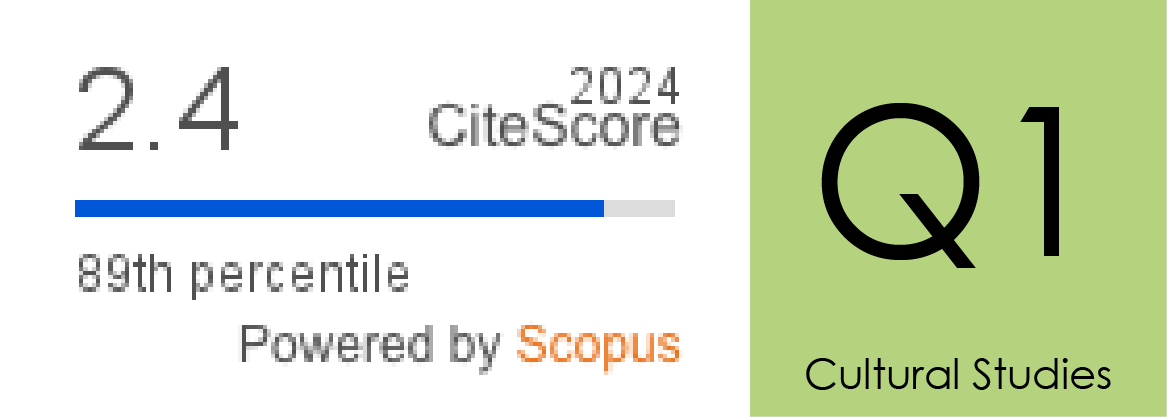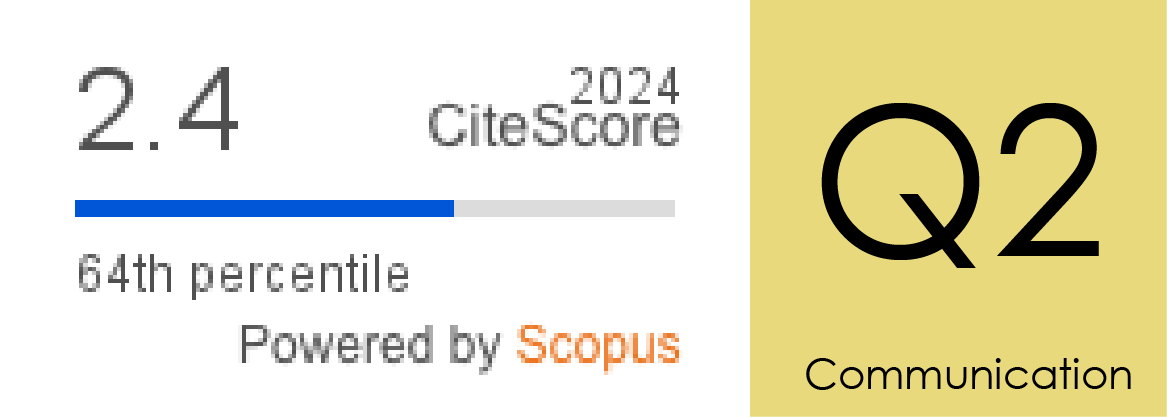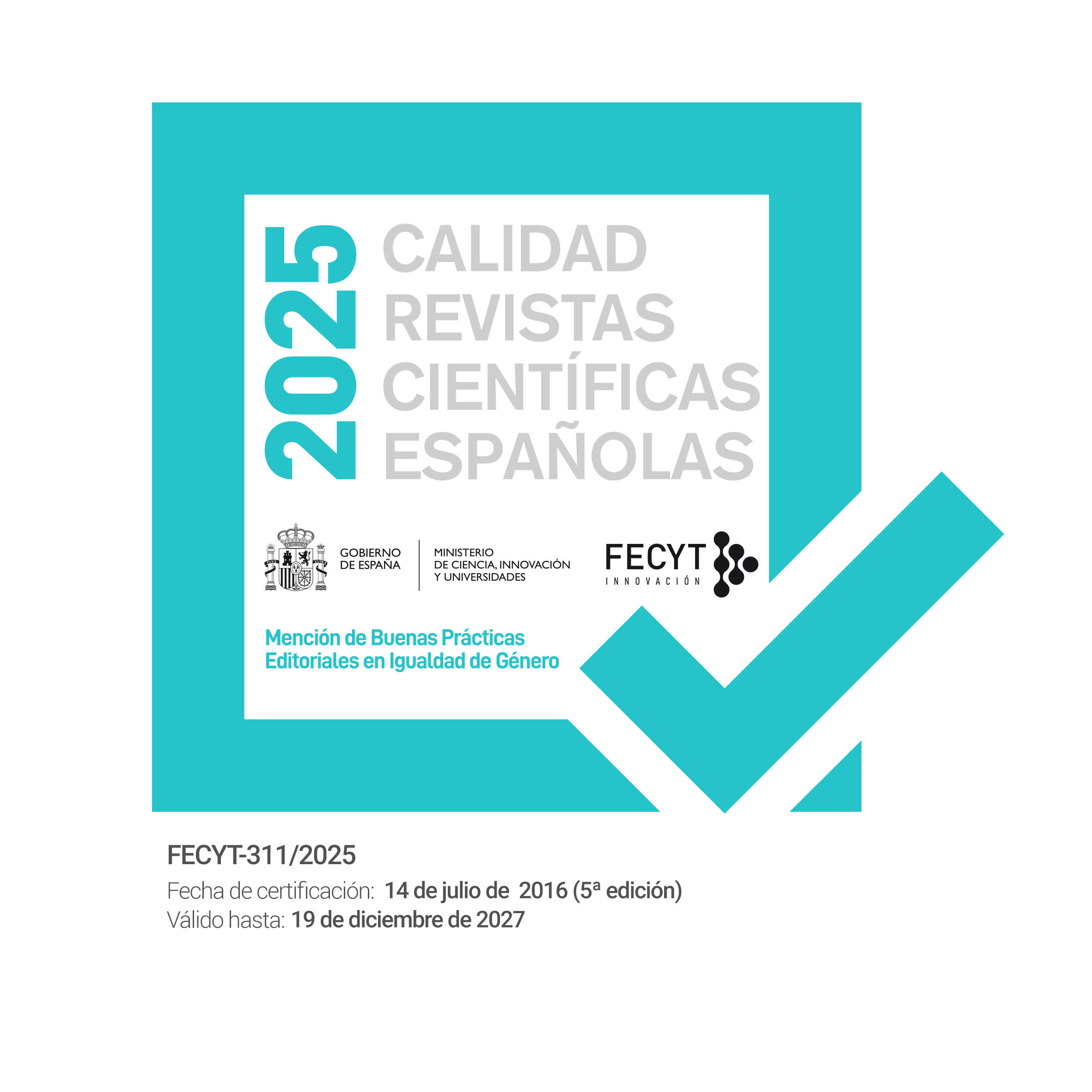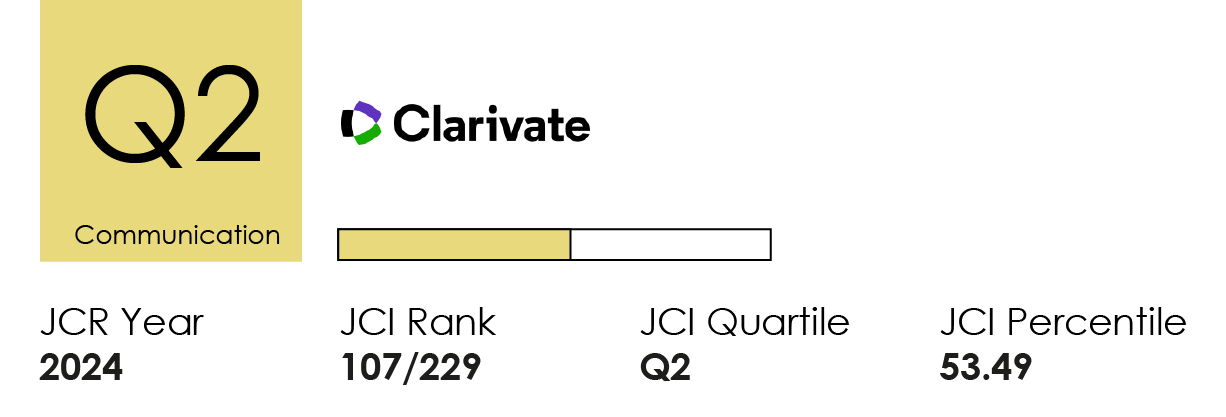Consumo de Netflix en México durante la Pandemia de Covid-19
DOI:
https://doi.org/10.14198/MEDCOM.23431Palabras clave:
Covid-19, Netflix, México, consumo, agencia, poderResumen
La pandemia de Covid-19 ha generado nuevas interacciones y cambios en las prácticas y hábitos de los usuarios de Netflix en México, estableciendo agencias que incluyen novedosas relaciones sociales y culturales. En esta línea de investigación, la intención de este artículo es identificar estos cambios y transformaciones, así como los “circuitos de poder” desarrollados por Netflix para producir, distribuir y vender sus contenidos audiovisuales. A partir del uso y la aplicación de una metodología de corte cuantitativo descriptivo se obtuvieron indicadores sobre el consumo regular y cotidiano de Netflix en México durante la pandemia después de aplicar cuestionarios a usuarios de la plataforma. Las principales observaciones del estudio distinguen una sólida integración de Netflix a las actividades cotidianas de consumo cultural, que consolida su poder, hegemonía y predominio en el mercado mexicano. Los principales hallazgos destacan el incremento en el uso de Netflix durante la pandemia de Covid-19, un aumento selectividad en los contenidos, mayor acceso compartido, un uso intensivo de los mecanismos de recomendación de la plataforma, el uso del fandom como base datos y el afianzamiento de intereses corporativos.
Financiación
Consejo Nacional de Ciencia y TecnologíaCitas
AMAI. (2018). Nivel Socio Económico AMAI 2018. Nota Metodológica. https://bit.ly/3NjMEM9
Andrejevic, M. (2012). Ubiquitous surveillance. In K. Ball, K. D. Haggerty, & D. Lyon (Eds.), Routledge Handbook of Surveillance Studies (pp. 91-98). Routledge.
Arielli, E. (2018). Taste and the algorithm. Studi di estetica, 12(3), 77-97. https://doi.org/10.7413/18258646062
Basuroy, S., Ravid, A., Gretz, R., & Allen, B.J. (2019). Is everybody an expert? An investigation into the impact of professional versus user reviews on movie revenues. Journal of Cultural Economics, 44(1), 57-96. https://doi.org/10.1007/s10824-019-09350-7
Bouquillion, P. (2019). Digital Audiovisual Platforms, Between Transnational Flows and National Frameworks. In E. George (Ed.), Digitalization of Society and Socio-political Issues 1 (pp. 107-116). ISTE Editions.
Couldry, N. (2018). Tracing Capitalism’s Turn to Data: Or Contextualizing Daily Life’s New Data “Context”. International Journal of Communication, 12, 701-705. https://bit.ly/3SPQRIO
Cuarón, A. (Productor). (2018). Roma. [Película]. Netflix Producciones.
Desrosières, A. (2012). Est-il bon, est-il méchant? Le role du nombre dans le gouvernement de la cité néolibérale. Nouvelles perspectives en sciences sociales. Revue internationale de systémique complexe et d’études relationnelles, 7(2). https://doi.org/10.7202/1013061ar
Duffer, M. (Productor). (2016). Stranger Things [Serie de TV]. Netflix Producciones.
Elkins, E. (2019). Algorithmic cosmopolitanism: on the global claims of digital entertainment platforms. Critical Studies in Media Communication, 36(4), 376-389. https://doi.org/10.1080/15295036.2019.1630743
Ekecrantz, J. (2011). Media and Communication Studies Going Global. In J. Wasko, G. Murdock y H. Sousa (Eds.), The Handbook of Political Economy of Communications (pp. 485-500). Blackwell Publishing.
Finn, E. (2017). What algorithms want: imagination in the age of computing. The MIT Press.
García-Leiva, M. T. (2019). Plataformas en línea y diversidad audiovisual: desafíos para el mercado español. Cuadernos de Información y Comunicación, 24, 73-93. https://doi.org/10.5209/ciyc.64639
Garnham, N. (2011). The Political Economy of Communication Revisited. In J. Wasko, G. Murdock y H. Sousa (Eds.), The Handbook of Political Economy of Communications (pp. 41-61). Blackwell Publishing.
Giddens, A. (1986). The Constitution of Society. Outline of the Theory of Structuration. Polity Press.
Gilligan, V. (Productor). (2008). Breaking Bad [Serie de TV]. Sony Pictures Television.
Gómez, R., & Muñoz, A. (2022). Netflix in Mexico: An Example of the Tech Giant’s Transnational Business Strategies. Television & New Media, 0(0), 1-18. https://doi.org/10.1177/15274764221082107
Gray, J. (2017). Reviving audience studies. Critical studies in Media Communication, 34(1), 79-83. https://dx.doi.org/10.1080/15295036.2016.1266680
Gunter, B. (2014). El proceso de investigación cuantitativa. En K. Jensen (Ed). La comunicación y los medios. Metodologías de investigación cualitativa y cuantitativa (pp. 209-234). Fondo de Cultura Económica.
Herbera, J., Linares, R., y Neira, E. (2015). Marketing Cinematográfico. Como promocionar una película en el entorno digital. Editorial UOC.
Hills, M. (2018). Netflix, transfandom and ‘trans TV’: Where data-driven fandom meets fan reflexivity. Critical studies in Television, 13(4), 495-498. https://doi.org/10.1177/1749602018797738
Izcara, S. P. (2007). Introducción al Muestreo. Miguel Ángel Porrúa.
Izquierdo, S. (2018). Managing the supply of short-life products. A duration analysis approach using the UK Film Industry. Bulletin of Economic Research, 71(1), 75-89. https://doi.org/10.1111/boer.12179
Jensen, K. (2014). La complementariedad de las metodologías cualitativas y cuantitativas en la investigación de medios y comunicación. En K. Jensen (Ed), La comunicación y los medios. Metodologías de investigación cualitativa y cuantitativa (pp. 254-272). Fondo de Cultura Económica.
Jin, D. Y. (2019). Transnationalism, cultural flows, and the rise of the Korean Wave around the globe. The International Communication Gazette, 81(2), 117-120. https://doi.org/10.1177/1748048518802911
Lin, C. (2019). The Challenge of Information and Comunication Divides in the Age of Disruptive Technology. Journal of Broadcasting & Electronic Media, 63(4), 587-594. https://doi.org/10.1080/08838151.2019.1699677
Lotz, A., Lobato, R., & Thomas, J. (2018). Internet-Distributed Television Research: A Provocation. Media Industries, 5(2), 35-47. https://doi.org/10.3998/mij.15031809.0005.203
Montaña, M., Ollé, C., y Lavilla, M. (2020). Impacto de la pandemia de Covid-19 en el consumo de medios en España. Revista Latina de Comunicación Social, 78, 155-167. https://www.doi.org/10.4185/RLCS-2020-1472
Murdock, G., & Golding, P. (2016). Political economy and media production: a reply to Dwyer. Media, Culture & Society, 38(5), 763-769. https://doi.org/10.1177/0163443716655094
Murdock, G. (2021). Dark Materials: Media, Machines, Markets. In J. Swartz y J. Wasko (Eds.), Media a Transdisciplinary Inquiry (pp. 44-64). Intellect.
Navarro, J. G. (2021). Subscription video on demand (SVoD) penetration rate in selected countries in Latin America in 2019. Statista. https://bit.ly/3sf3iTP
Navarro, J. G. (2022a). Leading video streaming services in Mexico in 2020. Statista. https://bit.ly/3yGfa4M
Navarro, J. G. (2022b). Most popular types of paid online entertainment services among internet users in Mexico in 2020. Statista. https://bit.ly/3ShBLf3
Odar, B., & Friese, J. (Productores). (2017). Dark [Serie de TV]. Netflix Producciones.
Pajkovic, N. (2022). Algorithms and taste-making: Exposing the Netflix Recommender System’s operational logics. Convergence: The International Journal of Research into New Media Technologies, 28(1), 214-235. https://doi.org/10.1177/13548565211014464
Pina, A. (Productor). (2017). La Casa de Papel [Serie de TV]. Netflix Producciones.
Poell, T. (2020). Three Challenges for Media Studies in the Age of Platforms. Television & New media, 21(6), 650-657. https://doi.org/10.1177/1527476420918833
Poell, T., Nieborg, D., & van Dijck, J. (2019). “Platformisation”. Internet Policy Review, 8(4), 1-13. https://doi.org/10.14763/2019.2.1414
Rios, S., & Scarlata, A. (2018). Locating SVOD in Australia and Mexico: Stan and Blim contend with Netflix. Critical Studies in Television: The International Journal of Television Studies, 13(4), 475-490. https://doi.org/10.1177/1749602018798158
Rogers, R. (2019). Doing Digital Methods. Sage.
Rouvroy, A. (2012). The end(s) of critique: data-behaviourism vs due-process. In M. Hildebrandt y E. De Vries (Eds.), Privacy, Due Process and the Computational Turn. The Philosophy of Law Meets Philosophy of Technology (pp. 143-167). Routledge.
Shapiro, S. (2020). Algorithmic Television in the Age of Large-scale Customization. Television & New Media, 21(6), 658-663. https://doi.org/10.1177/1527476420919691
Schumpeter, J. (2012). Capitalism, Socialism, and Democracy. Start Publishing.
Statista. (2022). Change in traffic to the most visited mobile apps during the COVID-19 outbreak in Mexico in March and April 2020. https://bit.ly/3sf2ezj
Stoll, J. (2022). Subscription video-on-demand (SVOD) revenue worldwide from 2016 to 2026. Statista. https://bit.ly/3EFs1If
Turner, G. (2019). Approaching the cultures of use: Netflix, disruption and the audience. Critical Studies in Television: The International Journal of Television Studies, 14(2), 222-232. https://doi.org/10.1177/1749602019834554
Vázquez, J., Negreira, M. C., & Pereira, X. (2017). Interactive documentary contributions to the renewal of journalistic narratives: realities and challenges. Revista Latina de Comunicación Social, 72, 397-414. https://doi.org/10.4185/RLCS-2017-1171
Vlassis, A. (2020). Global online platforms, COVID-19, and culture: The global pandemic, an accelerator towards wich direction?. Media, Culture & Society, 43(5), 957-969. https://doi.org/10.1177/0163443721994537
Wasko, J. (2018). Studying Political Economies of Communication in the Twenty-First Century. Javnost-The Public. Journal of the European Institute for Communication and Culture, 25(1-2), 233-239. https://doi.org/10.1080/13183222.2018.1424031
Descargas
Estadísticas
Publicado
Cómo citar
Número
Sección
Licencia
Derechos de autor 2018 César Bárcenas Curtis

Esta obra está bajo una licencia internacional Creative Commons Atribución 4.0.
Los autores y autoras que publican en esta revista están de acuerdo con los siguientes términos:
1 Derechos de autor. Los autores y autoras conservan sus derechos de autor, aunque ceden a la revista de forma no exclusiva los derechos de explotación (reproducción, distribución, comunicación pública y transformación) y garantizan a esta el derecho de primera publicación de su trabajo, el cual estará simultáneamente sujeto a la licencia indicada en punto 2. Los autores pueden establecer otros acuerdos adicionales para la distribución no exclusiva de la versión de la obra publicada en la revista, siempre que exista un reconocimiento de su publicación inicial en esta revista.
© Los autores.
2 Licencia. Los trabajos se publican en la revista sujetos a la licencia de Reconocimiento 4.0 Internacional de Creative Commons (CC BY 4.0); los términos se pueden consultar en https://creativecommons.org/licenses/by/4.0/
Esta licencia permite a terceros compartir (copiar y redistribuir el material en cualquier medio o formato) y adaptar (remezclar, transformar y crear a partir del material para cualquier finalidad, incluso comercial), siempre que se reconozca la autoría y la primera publicación en esta revista (Revista Mediterránea de Comunicación (RMC) / Mediterranean Journal of Communication (MJC), Universidad de Alicante, DOI de la obra), se proporcione un enlace a la licencia y se indique si se han realizado cambios en la obra.
3 Política de autoarchivo. Se recomienda a los autores que difundan sus trabajos a través de Internet para favorecer una circulación y difusión más rápidas y, con ello, un posible aumento en la citación y alcance entre la comunidad científica y académica, en las siguientes condiciones:
No se permite a los autores depositar en un repositorio institucional o temático, página web propia, etc., las versiones preprint (versión antes de ser evaluada) o postprint (versión evaluada y aceptada para su publicación) de sus trabajos antes de su publicación, pero sí el artículo final publicado (versión del editor).













